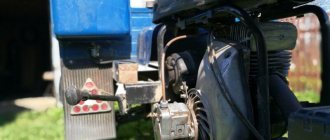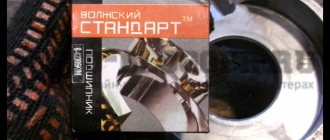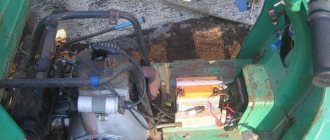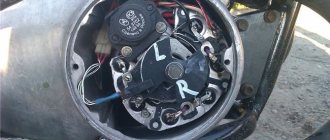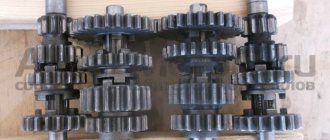Tula electric truck Ant - now also for the police?
“What a face you have, Sharapov!” — I want to exclaim, looking at the Ant electric truck produced by Tulamashzavod. This plant, known for its weapons (automatic cannons for armored vehicles and helicopters, naval artillery mounts, anti-aircraft guns, etc.), even at the Army 2019 exhibition showed the “fruit of conversion” - the Ant mini-truck with electric drive.
Its basic load capacity is one ton, the drive is either only from batteries, or also from an on-board diesel generator, the Chinese electric motor develops only 5 kW, and the batteries... Do you think lithium-ion? No matter how it is, they are ordinary lead-acid ones that produce a voltage of 48 V.
In the fiberglass cabin, made in Vladimir, there is a steering wheel from a Lada of the tenth family. The power reserve is not officially reported, but it seems that the car should travel up to 90 km without a load, and its maximum speed is only 22 km/h.
It’s interesting that Tula residents position Ant as the heir to the scooter of the same name. By the way, I rode a little on such a scooter last summer along a field road just outside Tula... A noble device!
At the same time, the new truck is officially called an “in-plant vehicle” - it is an electric vehicle that does not require license plates when used in closed areas. By the way, there are plenty of them in Europe: similar electric cars are regularly demonstrated at an exhibition in Lyon, France.
I thought that Ant's revival would end with prototypes, but in May last year it became known that an electric truck could be bought. There is even an Internet configurator, judging by which, the plant can change almost all indicators: body length (1.86-2.86 m), load capacity (1-2 tons), power (4-10 kW), battery capacity (165-340 Ah), and the version with the most capacious batteries will supposedly be able to travel up to 340 km, which is hard to believe.
The price tag on the website again supposedly starts at 787,000 rubles, but it is further stated that the basic equipment without an awning, stove and winter tires costs 1,150,000 rubles, but it is stated above that the price when ordering online is 1.2 million rubles. If you add a little more, you can take Gazelle Next!
And we managed to catch two such cars on the Simferopol highway. They were transported on tow trucks, not from Tula, but in its direction - apparently, the trucks were returning from testing or certification. Unlike the prototype, these cars have lost sliding windows on the sides (but there is now such a window in the back!), and the bodies are different, but otherwise everything is the same, and the battery voltage is indicated on the electrical equipment under the body, 48 V.
The most curious thing is that the cab of one of the Ants has police colors on it! From this we can assume that the appearance of such “electric cops”, only probably with different bodies, is possible in pedestrian and other environmentally friendly areas.
Photo report: Installing a piston on a motorcycle “Izh”, “Ant”, “Voskhod”
In matters of choosing one or another engine repair strategy. When it comes to repairing Soviet two-stroke motorcycles, it is advisable to adhere to a strategy that involves the complete restoration of original parts. And if this is not possible, with a creaky heart, you are forced to buy counterfeit goods or look for a used option.
- In the case of piston engines, a good repair involves, first of all, boring the cylinder to the repair size and installing a new piston, rings and pin. If you are lucky enough to find a Soviet-made cylinder, the best option would be to bore it to repair size, install a new piston, albeit a counterfeit one, and then such a piston is guaranteed to last for several seasons. And what’s most important is that boring costs only 400 rubles + a new piston, rings, pin, the total cost is no more than 1000 rubles
Motor scooter Ant: technical characteristics
Among the most important parameters of this technique, the following are worth highlighting:
- length – 268 cm;
- width – 125 cm;
- height – 107.5 cm;
- body dimensions – 125*113 cm;
- maximum load capacity – 250 kg;
- type of power unit - two-stroke, single-cylinder;
- engine volume – 199 cm3;
- power – 11 horses;
- maximum speed is 60 kilometers per hour.
Many supporters of domestic vehicles are confident that the characteristics of the Ant scooter are in no way inferior to their European counterparts.
Assembly
Insert the retaining ring into the piston boss. The ring should fit into the boss tightly and evenly around the entire circumference
- If the ring is not seated tightly, straighten it or replace it with a new one.
We heat the piston with a technical hair dryer and insert the piston pin into the boss so that it extends slightly inside the piston
Lubricate the upper connecting rod bushing with any engine oil. We turn the piston with the arrow towards the exhaust (on Jupiters - towards the inlet). We put the piston on the connecting rod, insert the extended pin into the hole in the upper head, drive the pin in and fix it with the second lock ring
We install the gasket and, from some clean container, bury engine oil into the bearing of the lower head of the connecting rod and the oil channels of the main bearings
Lubricate the piston thoroughly with oil, install the rings and tighten them with a clamp. We make a clamp from tin: cut out a strip of the required width, use it to make a clamp and voila!
After the rings go into the cylinder, remove the clamp and push the cylinder all the way
After installing the cylinder, hold it with your hand and try to turn the crankshaft:
- If the piston moves easily in the cylinder without crunching or jamming, install the gasket and screw on the cylinder head
- If the piston moves tightly with a crunching sound, or sticks, remove the cylinder and see what you did wrong
Source of the article: https://alisa-motors.ru/ustanovka-porshnevoj-na-sovetskie-motocikly-izh-muravej-vosxod/
How much does the Ant scooter cost?
At the time of release, such a device cost about 775 rubles. (Soviet).
The price was quite low, thanks to which the vehicle became widespread among our residents. Now the cost has not gone up much, so you can buy Ant motorcycles at a very affordable price. On the other hand, the production of such bikes has long ceased, so now you can choose a suitable model exclusively on the secondary market.
Quality of parts
The “quality” of parts for Soviet motorcycles that are currently on sale does not correspond to even the worst Soviet models. The Soviet one was not ideal either - believe me. The only thing there were no complaints about was the quality of the metal, but the manufacturing accuracy of Soviet manufacturers was lame and very, very bad
Rings
When purchasing new rings, insert them into the cylinder (new or after boring) and check for clearance
- If the rings fit tightly, we buy
- If the rings do not fit the mirror, try others
An example of a perfect fit of a ring to a mirror (“Ant”)
After checking for fit, we put the rings on the piston and measure the gap between the ring and the piston groove with a feeler gauge.
- If the gap is greater than 0.01-0.02 mm, try another ring
- If after several tried rings the gap is larger than expected, we try another piston
Voskhod piston with a gap clearly exceeding all conceivable standards
“Ant” piston with permissible clearance
Piston
One of the most dangerous and common problems in new pistons is the incorrect position of the ring stoppers. Customers have already brought pistons several times that had problems with the location of the stoppers
- Before purchasing a piston, use some pliers to tug on the stopper
- If the stopper is wobbly, we debug this piston and take the next one for check
Consequences of a flying stopper (“Ant”)
If the stopper fits tightly, place marks opposite the stoppers and insert the piston into the cylinder so that it does not reach the windows. Afterwards, we turn the piston so that it becomes exactly the same as in the engine. That is, the arrow is forward, and the axis of the finger is strictly along the axis of the crankshaft and look:
- If at least one risk has become opposite the windows or next to the window, we debug the piston and take another
- If there are risks between the windows, we buy
The main disadvantages of a scooter and its modernization
Motor scooter Ant and his carburetor
The Ant scooter, like any technology, in addition to its positive qualities, also had disadvantages. At the same time, the existing shortcomings could be attributed both to structural ones, originally inherent in the device, and to operational ones, arising during the operation of the equipment.
According to reviews from owners, structural defects that required rework or the most frequent repair of a particular unit include:
- an unsuccessful electrical circuit of the scooter, often leading to failure of components (din-starter, relay-regulator, ignition coil), especially in rainy weather;
- an undeveloped gearbox device often with poor-quality factory assembly led to a crash during 2nd or 3rd gear operation. To fix it, the owners had to study the structure of the box itself, as well as how to properly disassemble and then reassemble the gearbox after repair;
- a small difference in fuel levels between the tank and the carburetor chamber led, when there was little fuel in the tank, to running on a lean mixture or stopping the engine.
The most common operational deficiencies are:
- unstable ignition on the Ant requiring frequent adjustments;
- short service life of brake pads;
- loss of hydraulic fluid from shock absorbers, requiring disassembly, refilling and reassembly of shock absorbers for repairs;
- malfunction of the electrical equipment of the starter dyno under the influence of dirt, water, dust. Repairs were carried out by disassembling and reassembling, checking the electrical circuit, searching for and replacing the failed element;
- occurrence of cracks in the frame;
- oil leak in the gearbox.
Very often, the owners, having gained experience in operating the Ant scooter, carried out modernization. But before starting to implement the changes, the following issues were resolved:
- How much is it?
- What will the modified Ant look like?
- How to find and collect the necessary materials for upgrading?
- How much will the scooter weigh after the modification and how will this affect the technical characteristics?
- How long will it take to remodel?
After receiving positive answers to these questions, work on changes was carried out. Tuning the Ant scooter, which made it possible to give it additional properties, boiled down to the following basic alterations:
- Installation of a dump body for transportation of bulk cargo.
- Change of appearance design.
- Installation of a coupling device that allows you to work with various trailed and semi-trailer devices and equipment.
Versatility, cost and maintainability allowed the TMZ Ant scooter to be compared in terms of production volume and popularity with such best Soviet models of motor vehicles as the heavy M 72 Ural motorcycle and the light road motorcycle for the Minsk 125 village.
Previous entry Izh Jupiter 3 - technical characteristics, review Next entry Izh Jupiter 4 - technical characteristics, improvement
A few words about the trailer
You can also make a trike yourself. The spaciousness of the body is indicated by the photo of the Ant scooter. A standard trailer consists of:
- stroller frame;
- L-shaped steel bracket;
- two clamps;
- tubular struts.
You will also be interested: New Ural motorcycles: continuation of domestic traditions
When working on the trike, it is very important to ensure that the trailer shell does not come into contact with the bracket. To increase the rigidity of the body, a steel gusset can be welded. In addition, it is important to make a homemade trike with an opening and removable tailgate. The sides and bottom are covered with boards. Additionally, the trailer is equipped with lighting equipment (dimensions, brake lights, turn signals).
Instructions
To make an all-terrain vehicle from a scooter, you will need to find a car that is in good condition.
It should be taken into account that the standard engine develops a power of 11 hp. and has low torque (displacement volume is only 200 cm³), which is not enough for dynamic acceleration of a home-made design and for overcoming off-road conditions.
Before you make an all-terrain vehicle from Ant, you need to decide on the concept of the car. To drive the rear wheels, a ready-made axle can be used, borrowed from VAZ or AZLK passenger cars with rear drive wheels. It is possible to use a separate reduction gear; the torque is transmitted to the wheels using axle shafts equipped with CV joints (for example, from an Oka compact car).
Frame design
Before assembly begins, drawing documentation is developed to allow the assembly of the engine and transmission units of the future all-terrain vehicle. The frame is assembled from sections of box-section steel profiles, which are connected by resistance welding. A platform is provided for installing the engine; the rear axle is bolted to the side members. Welding stockings is prohibited, since the resulting structure is not durable. The front shield from the scooter is integrated into the frame, which protects the driver’s feet from flying dirt.
To install the front wheels, a subframe is assembled, which is attached to the standard steering column. Wheel hubs are mounted on levers that allow the tires to move in a vertical plane. Shock absorbers with springs are introduced into the design to stabilize wheel vibrations. The resulting structure is cleaned of rust and then covered with a layer of special primer. It is recommended to paint the frame with synthetic impact-resistant enamel, which protects the metal from corrosion during operation of the all-terrain vehicle.
Engine Installation
The engine is installed in its original place through rubber gaskets that reduce vibration levels. To increase torque, several reduction chain drives are installed; the location of the gears is thought out at the frame design stage. It is necessary to ensure the tension of the chains, which should not break off the gears during sudden acceleration of the all-terrain vehicle. The motor retains the dynastarter, complemented by a manual start lever. The battery is placed on the top of the frame (to a point that is not filled with water and liquid mud).
Chassis and wheels
Hubs with brake mechanisms are installed on the rear axle, which are connected to the handle on the steering wheel. Discs are mounted on the hubs, which are enlarged by welding an additional rim. Ready-made tires with a developed off-road tread are used; it is possible to manufacture homemade tires from a tube installed in a metal frame. The disadvantage of the homemade design is the low strength of the rubber of the camera, which is pierced by branches or cut by sharp stones when driving along country roads.
The all-terrain vehicle can be equipped with 1 front wheel or 2 tires mounted on a rotating subframe. Front-wheel drive is not provided due to the low engine power and complex kinematic diagram, which is difficult to implement in artisanal conditions. It is possible to use a stationary frame with a steering mechanism and steering knuckles connected to each other by a rod. Instead of a standard scooter steering wheel, a steering wheel borrowed from Russian or imported cars is used.
It is possible to build an all-terrain vehicle from Ant on tracks; in this case, 2 seats for the driver and passenger are placed on a rectangular frame, and a motor with a gearbox is installed behind it.
The chassis consists of support rollers and a rubber track with metal transverse elements. The drive wheel transmits torque to the crossbars; a front roller with a screw mechanism for tensioning the caterpillar track is provided. There is no suspension in the design, the machine is capable of moving through swampy areas and deep snow.
Main advantages of the model
Among the reasons why the Ant motorcycle has enjoyed and enjoys wide popularity are:
- reverse function, which greatly increases the maneuverability of the vehicle (especially important when parking and performing other complex maneuvers);
- a motor that starts with a starter;
- small turning radius of 3.5 m. Thus, you can ride a tricycle even along narrow rural streets;
- light weight compared to sidecar motorcycles;
- affordable price for the vehicle.
Among the disadvantages are high fuel consumption, fairly frequent breakdowns, as well as poor maneuverability on soft ground (especially when the body is loaded).



